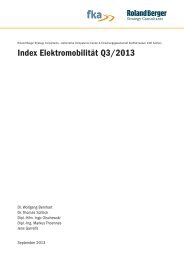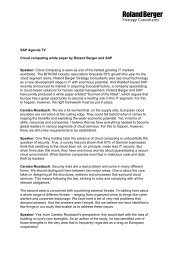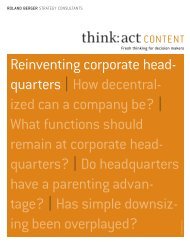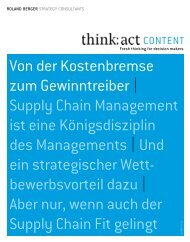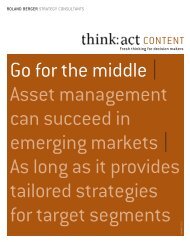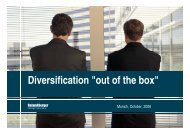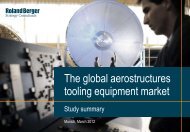operations flexibility in process industries - Roland Berger Strategy ...
operations flexibility in process industries - Roland Berger Strategy ...
operations flexibility in process industries - Roland Berger Strategy ...
You also want an ePaper? Increase the reach of your titles
YUMPU automatically turns print PDFs into web optimized ePapers that Google loves.
OPERATIONS FLEXIBILITYIN PROCESS INDUSTRIESFebruary 20091
AIntroduction33
The study covers three <strong>process</strong> <strong>in</strong>dustries with similarcharacteristics <strong>in</strong> <strong>operations</strong>Scope of the studySPECIALTYPHARMACEUTICALSCONSUMER CARECHEMICALSSIMILARITIES OFOPERATIONS• Capital <strong>in</strong>tensiveproductionequipment withlong depreciablelife• Broad productportfolios• Batch productionExamples:• Adhesives• Coat<strong>in</strong>gs• Pigments• Solutions• Additives• Agents• Solvents• etc.Examples:• Anesthetics• Infusions & <strong>in</strong>jections• Cl<strong>in</strong>ical solutions• Tablets & pills• Cl<strong>in</strong>ical nutrition• Cl<strong>in</strong>ical agents• etc.Examples:• Hygiene products• Beverages & water• Clean<strong>in</strong>g agent• Wash<strong>in</strong>g powder• Foodstuffs• Dairy products• etc.• Regulatoryrequirements• Global<strong>operations</strong>4
Four major trends put challenges for companies <strong>in</strong> all analyzed<strong>process</strong> <strong>in</strong>dustriesKey common trends <strong>in</strong> <strong>process</strong> <strong>in</strong>dustriesTRENDSWhat are the key challenges your company faces today?82%76%61%55%VolatileMergers & AquisitionsVolatileShortened product lifedemandenergy & rawcyclespatternsmaterial marketsCOMMENTS• Volatile demand patterns is namedas the highest current challenge;while at the moment mostcompanies experience an upsw<strong>in</strong>gand struggle to serve marketdemand there is awareness thatthe next downturn is com<strong>in</strong>g• Mergers & acquisition comessecond and puts companies undera constant restructur<strong>in</strong>g andreorganization pressure• Volatile energy and raw materialmarkets put the challenge to limitthe upwards trend by secur<strong>in</strong>gbenefits from short term drops• The shorten<strong>in</strong>g of product life leadsto a constant ramp up-/ downcycle the needs to be managed6MUC-
Eight trends <strong>in</strong> the pharmaceutical <strong>in</strong>dustry require more and more<strong>flexibility</strong> <strong>in</strong> <strong>operations</strong>PHARMA-CEUTICALS12 3Patents areProduct life cyc-New monitor<strong>in</strong>gCost pressurerunn<strong>in</strong>g out on les are shorten<strong>in</strong>g standards are from health payersmajor blockbuster due to reduced chang<strong>in</strong>g frequently<strong>in</strong> the demand<strong>in</strong>g pharma-is ever <strong>in</strong>creas<strong>in</strong>gdrugs puts pressure patent protectionon operational cost requires faster pharma <strong>in</strong>dustry economic benefitsstructure t adjustmentt ramp-up and ramp requir<strong>in</strong>g ii quickdown of <strong>operations</strong> adaptations45 6Competition fromProduct diversityVelocity of tech-Asia is <strong>in</strong>creas<strong>in</strong>g is <strong>in</strong>creas<strong>in</strong>g due nology developmentsrequires a more to more and moreis <strong>in</strong>crea-global footpr<strong>in</strong>t personalized s<strong>in</strong>g along the(India and Asia but productspharma valuealso Russia)cha<strong>in</strong>78Mergers andacquisitions as aresult of portfoliooptimization requirequick and efficientcarve-out and<strong>in</strong>tegration of<strong>operations</strong>Source: <strong>Roland</strong> <strong>Berger</strong>7
Five trends <strong>in</strong> the specialty chemicals <strong>in</strong>dustry require more andmore <strong>flexibility</strong> <strong>in</strong> <strong>operations</strong>1 2 3SPECIALTYCHEMICALSMergers and acqui-CompaniesCont<strong>in</strong>uous reviewsitions as a result ofportfolio optimizationrequire quick andefficient carve-out and<strong>in</strong>tegration ti ofextend<strong>in</strong>g theirvalue cha<strong>in</strong> andbecom<strong>in</strong>g solutionproviders to evadecommoditization ofof manufactur<strong>in</strong>gpenetration to freecash for <strong>in</strong>novation<strong>operations</strong>their products4 56Competition fromAsia is <strong>in</strong>creas<strong>in</strong>grequire shorterreaction time towardscustomers and thus amore global footpr<strong>in</strong>tPressure toestablish scalesynergies to be costcompetitive whileavoid<strong>in</strong>g asset buildupImproved on-shelfavailability due to<strong>in</strong>creased competitionand decl<strong>in</strong><strong>in</strong>gcustomer loyaltySource: <strong>Roland</strong> <strong>Berger</strong>8
Six trends <strong>in</strong> the consumer goods <strong>in</strong>dustry require more and more<strong>flexibility</strong> <strong>in</strong> <strong>operations</strong>1 2 3CONSUMERCAREVolatile demandShortened productIncreased productpatterns due tochang<strong>in</strong>g consumerbehaviour andseasonal variationslife cycles due to<strong>in</strong>creased competition,technologicalimprovements and<strong>in</strong>creas<strong>in</strong>g i customerdiversity due tocustomers demand<strong>in</strong>gmore and morepersonalizedproductsrequirements4 56Increased variety <strong>in</strong>packag<strong>in</strong>gdue to regionalregulations and<strong>in</strong>creaseddifferentiation needsExtended cross-boarder activitiesdue to further<strong>in</strong>ternationalizationand limited growthoptions <strong>in</strong> homemarketsImproved on-shelfavailability due to<strong>in</strong>creased competitionand decl<strong>in</strong><strong>in</strong>gcustomer loyaltySource: <strong>Roland</strong> <strong>Berger</strong>9
Most companies <strong>in</strong> the <strong>process</strong> <strong>in</strong>dustries have recognized theneed for <strong>flexibility</strong>VerbatimsJeffry B. K<strong>in</strong>dler (CEO)"We must reduce our absolute cost andput <strong>in</strong> place a more flexible structure"Kurt Hogh (Value stream optimization)"…Stricter market requirements (<strong>in</strong> terms of freshhigh-quality chocolate, volume adjustments, moredemand<strong>in</strong>g customers,…) and strategic targetsmean that <strong>flexibility</strong> must be at the heart of ourcompany …" 1)"… our bus<strong>in</strong>ess now meets allconditions for long-term success: flexibleasset structures … and a global focusbacked by regional <strong>flexibility</strong>…"(Annual report 2007)1) Translated from German sourceDr. Ra<strong>in</strong>er Oschmann(Executive General Manager)"… Operations <strong>flexibility</strong> is a clearstrategic objective of our company… ""Great <strong>flexibility</strong> is really importantso that we can rapidly adapt to …how our local customers work."(Letter to shareholders, June 2007)"… Flexibility will have an ever<strong>in</strong>creas<strong>in</strong>g relevancy <strong>in</strong> order toreduce capital tie-up and to be ableto react more quickly…"(Annual report 2007 1) )" [Our] f<strong>in</strong>ancial strength is therefore theresult of the followed strategic course andof the <strong>flexibility</strong> and speed with whichexternal challenges are dealt with."(Mission statement 2008)10
Participants of this study confirm the relevance of <strong>flexibility</strong> –however systematic transfer <strong>in</strong>to their <strong>operations</strong> strategy is rareFlexibility objectives and <strong>operations</strong> strategyASSESSMENTS ON OPERATIONS FLEXIBILITYDo you perceive <strong>operations</strong> <strong>flexibility</strong> as one of yourtop 5 priorities?89%yes11%Do you systematically def<strong>in</strong>e strategic measures toachieve this objectives?56%no44%Beverage producer, Production manager"… <strong>operations</strong> <strong>flexibility</strong> is very important<strong>in</strong> our capital <strong>in</strong>tensive <strong>in</strong>dustry…"Specialty chemicals company, COO"… <strong>flexibility</strong> is much more economicalthan <strong>in</strong>vest<strong>in</strong>g <strong>in</strong> forecast<strong>in</strong>gexcellence … we had to learn it thehard way…"Speciality chemicals company,Head of Strategic Plann<strong>in</strong>g"Operations <strong>flexibility</strong> is so<strong>in</strong>evitably important. It would befoolish if we left it to chance."Pharma and Chemicals Group,Head of Bus<strong>in</strong>ess development"Def<strong>in</strong>itely, <strong>flexibility</strong> is among ourstrategic goals. We would soon beout of the market if we would notconstantly try to react as flexibly aspossible."Consumer Care company; Managermanufactur<strong>in</strong>g"Only when we felt the strong market pushand had to quickly boost our output did werecognize significant hidden <strong>flexibility</strong>buffers; <strong>in</strong> one plant we where able to<strong>in</strong>crease output by 15% without any<strong>in</strong>vestments"yesnoPharmaceutical producer, Head of Operations"We do build <strong>in</strong> <strong>flexibility</strong> but it is rather a functionalresponsibility than a systematic corporate approach"Source: <strong>Roland</strong> <strong>Berger</strong> <strong>in</strong>terviews, 200811
BIndustry trends drive <strong>flexibility</strong> requirements1212
Different <strong>flexibility</strong> types exist: from handl<strong>in</strong>g of day-to-daydemand fluctuation to strategic considerations for M&A activitiesTypes of <strong>flexibility</strong>TYPEEXPLANATIONEXAMPLE1Demand• The capability to deal with volatiledemand patterns• Increase <strong>in</strong> the advent of a new productor the downturn at the end of theproduct life cycle2Geography• The capability to <strong>in</strong>stall necessary<strong>operations</strong> for a new market entry• (e.g. local supplier <strong>in</strong>tegration)• Entry <strong>in</strong>to Ch<strong>in</strong>ese market mak<strong>in</strong>g use oflocal labour cost advantages (keep<strong>in</strong>gup necessary <strong>in</strong>gredient quality)3Network• The capability to change volume andproduct allocation with<strong>in</strong> a global siteportfolio• e.g. new products, market demand shiftsor currency changes might require anoptimized utilization of global sites4Technology• The capability to replace old technologywith new technology• e.g. new small batch technologiesrequire different skills and productionsystem set-ups5Mergers & Acquisitions• The capability to make use of synergiesor reta<strong>in</strong> exist<strong>in</strong>g synergies <strong>in</strong> the caseof <strong>in</strong>vestment and divestments• Integration of newly acquired plants <strong>in</strong>toan exist<strong>in</strong>g production network13
For the analyzed <strong>in</strong>dustries, the different types of <strong>flexibility</strong> havedifferent relevancy – demand <strong>flexibility</strong> is a common requirementRelevancy of different <strong>flexibility</strong> typesSPECIALITYCHEMICALSPHARMA-CEUTICALSCONSUMERCARELowHighLow High Low High1DemandDemandDemand2GeographyGeographyGeography3NetworkNetworkNetwork4TechnologyTechnologyTechnology5Mergers &acquisitionsMergers &acquisitionsMergers &acquisitionsSource: <strong>Roland</strong> <strong>Berger</strong> <strong>in</strong>terview results, 200814
1 DEMAND FLEXIBILITYPredict<strong>in</strong>g yearly flu types is very difficult for the pharmaceutical<strong>in</strong>dustry – demand for one serum can be very high or zeroExample: Flu serumDemanddemand for specificvirus (later: type A)• Serum has to be reproduced every year, as the virustransforms every year• Inventories are therefore not possible• WHO gives a yearly recommendation, which serumshould be produced/normally three types of viruses arecovered• Development of year specific serum takes up to 6 months• Extremely high demand of <strong>in</strong>cubated eggs for repro-duction of antibodies (Impfviren), capacities are limited• Serum manufacturers expect that demand will doublewith<strong>in</strong> the next 10 years, result<strong>in</strong>g <strong>in</strong> production capacitiesrestra<strong>in</strong>tsReal demandfor type Ademandtyoe Cdemandtype BAutumn Summer Fall W<strong>in</strong>terSource: Pandemic Report 2006tBackgroundProblem• Only one serum is really needed for one specific type• Production capacities have to be extremely flexible toreact to a specific demand• Limited production capacities15
2 GEOGRAPHICAL FLEXIBILITYManufactur<strong>in</strong>g networks will cont<strong>in</strong>ue to go through a significanttransformation <strong>process</strong> <strong>in</strong> the futureAttractiveness of market and production environmentDevelop<strong>in</strong>g countries will further <strong>in</strong>crease<strong>in</strong>dustrial assets and production capacitiesExist<strong>in</strong>g production networkswill transformHighCh<strong>in</strong>a• Rationalization of WesternEuropean <strong>in</strong>dustriesMarketattractiveness 1)ItalyIndiaFranceGermanySouth AfricaMexicoCzechRepublicChile• Significant development of<strong>in</strong>dustrial assets <strong>in</strong> EasternEuropean regions and Asia• Production overcapacitieswill occur <strong>in</strong> Europe• Need for geographical<strong>flexibility</strong> of <strong>operations</strong> thuswill <strong>in</strong>creaseLowLowProductionattractiveness 2)HighSize <strong>in</strong>dicates market size1) Growth, Attractivity etc.2) Labor cost, country risk, <strong>in</strong>frastructure16
3 NETWORK FLEXIBILITYFlexible production networks allow companies to adapt tochang<strong>in</strong>g market conditions on a short-term baseManufactur<strong>in</strong>g network aspectsExplanation100%ProductioncapacityProductionvolume• Use of flexibleproduction volumes• e.g. use morevolume/capacities dueto currency advantage• Volatiledemand asksfor productionvolume shifton a shortterm base• Degree ofvalue added isdecreas<strong>in</strong>gVolatile demandpatternDegree of valueadded• Production oflabour<strong>in</strong>tensiveproducts• Make use ofrelative costpositionsShare ofvalue addedLabor costst• Make use of globalproduction networks,e.g. shift productionvolumes andproduction of lowvalue-add<strong>in</strong>gcomponents• Be able to react on ashort-term base onchang<strong>in</strong>g bus<strong>in</strong>esscharacteristics17
4 PRODUCT TECHNOLOGY PORTFOLIO FLEXIBILITYState of the art product technologies are needed to decrease costs– product technology <strong>flexibility</strong> is seen as key enablerExample: Energy consumption and costsEnergy consumption[Terajoule]1,000800600400200Costs[Eurocent/kWh]001994 1996 1998 2000 2002 2004 2006 200810 • Energy consumption is grow<strong>in</strong>gsteadily8642• Energy costs rose with a CAGRof 12,7% from 2000-2007• The capability to replace old withnew technology will <strong>in</strong>creaseproduction efficiency anddecrease costsManufactur<strong>in</strong>g <strong>in</strong>dustriesEurocent/kWhSource: Statistisches Bundesamt / VCI-Chemiewirtschaft <strong>in</strong> Zahlen 2007 / BDI18
5 BUSINESS PORTFOLIO FLEXIBILITYM&A activities and value cha<strong>in</strong> reconfiguration require <strong>operations</strong>to be flexible towards portfolio changesBus<strong>in</strong>ess portfolio <strong>flexibility</strong>Bus<strong>in</strong>esstrendsM&A transaction value Europe [USD m]100,00080,000000ConsumerGoods60,000Pharma40,00020,000Chemicals01994 1996 1998 2000 2002 2004 2006 2008Drivers for portfoliochanges• M&A activities– Until 2004: ma<strong>in</strong>ly cost-focused– S<strong>in</strong>ce 2005: ma<strong>in</strong>ly growth-oriented• Ongo<strong>in</strong>g changes <strong>in</strong> Value Cha<strong>in</strong>Configuration– Competition of value cha<strong>in</strong>srather than companies– Forward and backwards<strong>in</strong>tegration and des-<strong>in</strong>tegrationOps challengesManufactur<strong>in</strong>g:Supply cha<strong>in</strong> management:Purchas<strong>in</strong>g:R&D:Process for product transfers, modular value cha<strong>in</strong>, flexible support functions,…Scalable distribution <strong>in</strong>frastructure, standardized <strong>process</strong>es and systems, …Global and regional sourc<strong>in</strong>g strategy, …Platform strategy, alignment with manufactur<strong>in</strong>g, …19
CHow to embed <strong>flexibility</strong> with<strong>in</strong> <strong>operations</strong>strategy2020
Choos<strong>in</strong>g the most suitable <strong>flexibility</strong> levers is often prevented byfour common ruptures along the strategy <strong>process</strong>Ruptures along the strategy <strong>process</strong>1. DEVELOPBus<strong>in</strong>essBus<strong>in</strong>essBUSINESS<strong>flexibility</strong>scenariosSCENARIOSneedsBus<strong>in</strong>essscenarios1st common rupture:Bus<strong>in</strong>ess <strong>flexibility</strong> needs are notsystematically assessed for top downstrategy development2. DEDUCTFLEXIBILITYNEEDSOperations <strong>flexibility</strong> needsManufactur<strong>in</strong>g Purchas<strong>in</strong>g SCM2nd common rupture:Bus<strong>in</strong>ess <strong>flexibility</strong> needs are notsystematically transformed <strong>in</strong>to <strong>operations</strong><strong>flexibility</strong> needs3. SELECT BESTFLEXIBILITYLEVERSFlexibility lever toolboxLevers applied3rd common rupture:Operations <strong>flexibility</strong> needs are notsystematically translated <strong>in</strong>to a consistentsystem of <strong>flexibility</strong> levers – Overlapsbetween levers generate a hidden <strong>flexibility</strong>4. MEASUREIMPLEMENTATIONEBITTargetActualt4th common rupture:Neither a systematic forecast nor controll<strong>in</strong>gof ga<strong>in</strong>s from <strong>flexibility</strong> is madeSource: <strong>Roland</strong> <strong>Berger</strong>21
1DEVELOP BUSINESS SCENARIOSEstablish<strong>in</strong>g <strong>flexibility</strong> starts with creat<strong>in</strong>g different bus<strong>in</strong>ess scenariosand assess<strong>in</strong>g the related cost and benefits of <strong>flexibility</strong>Determ<strong>in</strong>ants of <strong>flexibility</strong> valueDifferent bus<strong>in</strong>ess scenarios trigger the needto evaluate cost and effects of becom<strong>in</strong>g moreflexible. Bus<strong>in</strong>ess scenarios can be calculatedwith different time horizons and <strong>in</strong>cidentprobabilitiesEBITScenario AOccurswithprobabilityThe cost of becom<strong>in</strong>g more flexible aredeterm<strong>in</strong>ed by the actual degree of <strong>flexibility</strong>and the cost of implement<strong>in</strong>g additional<strong>flexibility</strong> measures. The type of measures tobe implemented crucially depends on the timehorizon of the bus<strong>in</strong>ess scenariosNo<strong>in</strong>vestment<strong>in</strong> <strong>flexibility</strong>IncidentP AThe benefits from <strong>flexibility</strong> are the effectsresult<strong>in</strong>g from the measures implementeddur<strong>in</strong>g the realization of one of the possiblebus<strong>in</strong>ess scenarios<strong>in</strong>vestment<strong>in</strong> <strong>flexibility</strong>Scenario BOccursCost of becom<strong>in</strong>g more flexibleEBIT development scenario AGa<strong>in</strong>s from <strong>flexibility</strong> scenario AEBIT development scenario BGa<strong>in</strong>s from <strong>flexibility</strong> scenario BwithprobabilityP B22AirbusTIMESource: <strong>Roland</strong> <strong>Berger</strong><strong>in</strong>terview
2DEDUCT OPERATIONS FLEXIBILITYBus<strong>in</strong>ess <strong>flexibility</strong> needs are often not systematically derived fromthe company's strategic objectivesL<strong>in</strong>k between strategic objectives and measuresCONCLUSIONNEGATIVE EXAMPLEIs <strong>flexibility</strong> part of yourstrategic objectives?• The majority ofparticipants confirm<strong>flexibility</strong> to be part oftheir strategy• Strategic objectives could be able tocope with demand <strong>in</strong>crease of 10%• Further divestments of <strong>operations</strong>61%assets; <strong>in</strong>crease of outsourc<strong>in</strong>g level39%Independent OP objectivesYes NoIs <strong>flexibility</strong> transferred asan objective of your<strong>operations</strong> strategy?t 59%41%• On the other hand a lotof companies lack thetransfer <strong>in</strong>to thedesiered <strong>flexibility</strong> oftheir <strong>operations</strong>Purchas<strong>in</strong>gManufactur<strong>in</strong>g• Demand fluctuations of -5% withoutpurchas<strong>in</strong>g price effect• Develop second supplier for keycomponent• Compensate 5% volume reduction <strong>in</strong>cost per piece• Prepare to <strong>in</strong>source 30% of volumefrom contract manufacturer• Build task force to prepare <strong>in</strong>tegrationof potential acquisitionYesNoSCM • Demand changes of 5% withoutdecreas<strong>in</strong>g service levelSource: <strong>Roland</strong> <strong>Berger</strong> <strong>in</strong>terview results, 200823Airbus<strong>in</strong>terview
3SELECT BEST FLEXIBILITY LEVERSSelection of <strong>flexibility</strong> levers is not always based on the respectiveimplementation cost and timeLevers selection matrixCost of implementationHighMed.LowIV.6III.8I.4 II.7I.3I.9II.4I.10I.1II.11III.1 IV.4II.10III.5IV.3II.1IV.5I.5 II.14IV.1III.3II.12I.2I.13III.3I.12 II.8I.6IV.2 II.2I.7 II.6 III.6IV.6II.3I.8II.5III.4I.11IV.8III.7 IV.9II.9Short-term Medium-term Long-termTime to implementSource: <strong>Roland</strong> <strong>Berger</strong>IIIIIIIVMANU-FACTU-RINGPUR-CHASINGSCM/LogisticsGENERALI.1 Optimize production footpr<strong>in</strong>tI.2 Use of multi-purpose plantsI.3 Buy options on <strong>in</strong>frastructure/real estateI.4 Jo<strong>in</strong>t facility utilizationI.5 Make-to-orderI.6I.7II.1II.2II.3II.4II.5II.6Keep options on future technologiesUse modular/flexible manufactur<strong>in</strong>gsystemsGlobal/cross-regional sourc<strong>in</strong>gMultiple sourc<strong>in</strong>gPeak sourc<strong>in</strong>gNegotiation/reflexRisk shar<strong>in</strong>g partnershipsSupplier collaborationIII.1 Warehouse footpr<strong>in</strong>t optimizationIII.2 Flexible warehouse dimension<strong>in</strong>gIII.3 Supply cha<strong>in</strong> collaborationIII.4 Outsourc<strong>in</strong>gIV.1 Partnerships/JVIV.2 Monitor<strong>in</strong>g systems/KPIIV.3 Standardized & scalable IT systemsIV.4 Modularization & standardization of<strong>process</strong>esIV.5 Cont<strong>in</strong>uous improvementI.8 Def<strong>in</strong>e pull/push po<strong>in</strong>tsI.9 Kanban utilizationI.10 Optimize change-over time and costI.11 Consider total lifecycle costsI.12 Reduce lead time <strong>in</strong> productionI.13 Introduce advanced operat<strong>in</strong>g schemesI.14 Postpone product differentiationII.7 Make-or-buyII.8 eProcurementII.9 Sale & lease backII.10 Standardization of product structureII.11 ModularizationII.12 CLB organizationIII.5Advanced plann<strong>in</strong>g systemsIII.6 Optimization of contractual conditionsfor assetsIII.7Shar<strong>in</strong>g of logistics assetsIII.8 Risk shar<strong>in</strong>g with logisticsservice providersIV.6 Flexible work<strong>in</strong>g hoursIV.7 Temporary workersIV.8Variable remunerationIV.9 Orientation on <strong>in</strong>dustry standards24
4MEASURE IMPLEMENTATIONDecisions regard<strong>in</strong>g <strong>flexibility</strong> are made with limited knowledgeabout cost and ga<strong>in</strong>s; effective measurement is neglectedTransparency of <strong>flexibility</strong>Do you measure <strong>flexibility</strong> of your <strong>in</strong>ternal<strong>operations</strong>?22%Yes31%Partly47%NoDo you measure the <strong>flexibility</strong> of yourexternal supply cha<strong>in</strong>?10%Yes35%Partly55%NoDo you know the cost of be<strong>in</strong>g moreflexible?60%30%10%YesPartlyNoQUOTES• "We build buffers and flexibilizework<strong>in</strong>g hours although h we are notreally sure these efforts pay off ..."• "Often we are not exploit<strong>in</strong>g our<strong>flexibility</strong> potentials where we couldbecause supplier are not transparent"• " We tackle <strong>flexibility</strong> needs whenthey occur, then we make a bus<strong>in</strong>esscase and calculate cost implications"• "What is more complex thencalculat<strong>in</strong>g l <strong>flexibility</strong> cost is to get toknow the benefits of <strong>flexibility</strong>"CONCLUSION• The majority of companiesdo only have a rough ideaabout their <strong>in</strong>ternal<strong>flexibility</strong>• Most companies cannotfully utilize their supplier<strong>flexibility</strong> because they donot measure it• Consequently decisionsregard<strong>in</strong>g <strong>flexibility</strong> aremade with limited knowledgeabout cost and ga<strong>in</strong>s• Effective measurementsystems are not fullyimplementedSource: <strong>Roland</strong> <strong>Berger</strong> <strong>in</strong>terviews, 2008Airbus<strong>in</strong>terview25
Us<strong>in</strong>g a systematic four step approach, the four common ruptures canbe overcome and the full value of <strong>flexibility</strong> can be utilizedFour step approachDEVELOP SCENARIOSCLUSTER OPERATIONS SELECT BEST SET OFCONTROL FLEXIBILITYFLEXIBILITY NEEDS FLEXIBILITY LEVERS GAINSEBITNo<strong>in</strong>vestment<strong>in</strong>levers<strong>in</strong>vestment<strong>in</strong> leversIncidentBest caseWorst casehighmediumlowProbability x SizeScenarioAScenarioBScenarioChighmediumlowCost of implementationUseallleverswithshortimpl.timeCondideronlymediumcost leversbut allowfor moretime toimplementCancelBe selectiveand reviewcont<strong>in</strong>uouslytshortmedium longTime to scenarioshortmedium longTime to implement• Evaluate different bus<strong>in</strong>essscenarios• Derive of <strong>flexibility</strong> needs foreach bus<strong>in</strong>ess scenario• Cluster specific <strong>flexibility</strong> needsfor each scenario along theproduct of probabiliy and size(benefit/risk) and time tillpotential occurance• Select levers that reflect theprobability x size category as wellas the time horizon of the scenario• Detect hidden <strong>flexibility</strong> bycompar<strong>in</strong>g feasible levers with• Constantly review flexibiltyga<strong>in</strong>s and costthose already implemented andcancel those 1st rupture closed 2nd rupture closed 3rd rupture closed 4th rupture closedSource: <strong>Roland</strong> <strong>Berger</strong>26
DBest practice <strong>flexibility</strong> levers2727
DEMAND FLEXIBILITY LEVERSLevers to tackle demand <strong>flexibility</strong> are well known, though theirimportance <strong>in</strong> the eyes of <strong>operations</strong> managers is chang<strong>in</strong>gTop levers address demand <strong>flexibility</strong>Rank # General Purchas<strong>in</strong>g Manufactur<strong>in</strong>g Supply cha<strong>in</strong>1IV.7TemporaryII.2Multiple/dualI.12Reduce lead timeIII.4workerssourc<strong>in</strong>g<strong>in</strong> productionII.6SuppliercollaborationI.15SubcontractoruseIII.4Push-pull-po<strong>in</strong>tdifferentiationOutsourc<strong>in</strong>g2IV.6Flexible work<strong>in</strong>gII.1Global/crossI.2Multi purposeIII.5hoursregional sourc<strong>in</strong>gplantsIII.10Advanced plann<strong>in</strong>gsystemsBuffer stocksComments• Temporary workers and<strong>in</strong>ternally flexible work<strong>in</strong>ghours <strong>in</strong> the most commonmeans to tackle demandfluctuation• Models of both leversstrongly depend on locallegislation• Multiple sourc<strong>in</strong>g or dualsourc<strong>in</strong>g is applied forcritical materials• For materials/serviceswhere this is most feasiblecollaboration models up toJV approaches are applied• For suppliers where secondsource is too expensivesometimes dual siteproduction at supplier isrequested/ supported• Lead time reduction isclearly highest on theagenda of manufactur<strong>in</strong>gresponsibles• Strategic <strong>flexibility</strong> is built <strong>in</strong>by us<strong>in</strong>g subcontractors forvolatile/peak demand• Multi purpose plants areconsidered whereeconomically feasible• A differentiated def<strong>in</strong>itionof push-pull-po<strong>in</strong>t (make-toordervs. make-to-stock)has risen <strong>in</strong> the attention• Outsourc<strong>in</strong>g rema<strong>in</strong>s anestablished lever to sharevolatility risk with serviceproviders• Buffer stock is used tocover sales upsw<strong>in</strong>gpotentials though focus ison lead-time reduction <strong>in</strong>production <strong>in</strong>steadSource: <strong>Roland</strong> <strong>Berger</strong> <strong>in</strong>terviews, 20082828
M&A FLEXIBILITY LEVERSWith regard to establish<strong>in</strong>g <strong>flexibility</strong> to better handle divestmentsand <strong>in</strong>tegrations, the clear focus is on more standardizationTop levers applied to address mergers & acquisitionsRank # General Manufactur<strong>in</strong>g Supply cha<strong>in</strong> Mgmt. Purchas<strong>in</strong>g1IV.9Orientation onI.1Optimize productionfootpr<strong>in</strong>tfootpr<strong>in</strong>tIII.1WarehouseII.12<strong>in</strong>dustry standardsProductionOutsourc<strong>in</strong>gIV.2StandardizedI.17II.7Monitor<strong>in</strong>g/ KPIsystemsystemsCorporate LeadBuyer organization2IV.3Standardized&scalable ITsystemsII.13Standards oncommodity codes&use of databasesComments• Industry standards is widelynamed as key to be flexible• Often though standards arecountry specific and thereach is thus limited• Standard KPI systems area key lever to quickly<strong>in</strong>tegrate new companiesand make themmanageable• IT standards are anadvantage but depend onthe target company's setup• Clearly still on the rise isthe <strong>in</strong>troduction ofproduction systems• Even if implementation willbe different a merge with acompany that has one isachieved much faster• In the context of PMI oftenoutsourc<strong>in</strong>g is helpful,provided the contract is setup <strong>in</strong> a flexible way for suchcases• Often companies take thechance to outsource dur<strong>in</strong>gM&A situations as thejustification case withregard to labor laws arebuilt more easily• A corporate lead buyerorganization is consideredby most of the participantsas highly adaptive to<strong>in</strong>tegrate or to be <strong>in</strong>tegrated• The <strong>in</strong>creas<strong>in</strong>g use ofstandard commodity andsupplier codes also is veryhelpful <strong>in</strong> <strong>in</strong>tegrationscenariosSource: <strong>Roland</strong> <strong>Berger</strong> <strong>in</strong>terviews, 200829
Dur<strong>in</strong>g the <strong>in</strong>terviews companies across all <strong>in</strong>dustries analyzedand gave an <strong>in</strong>sight <strong>in</strong>to how they establish <strong>flexibility</strong>Overview <strong>flexibility</strong> casesCASEFLEXIBILITY TYPES1 De-2 Geo-3 Net-4 Tech-5mandgraphyworknologyM&AINDUSTRYPharma Consumer Chemical1. 1 Central coord<strong>in</strong>ation department2. 2Volatile demand consumer good<strong>in</strong>dustry3. 3 Fast grow<strong>in</strong>g markets <strong>in</strong>consumer good <strong>in</strong>dustry . 4 External <strong>in</strong>termediate bus<strong>in</strong>ess asa buffer5Facilitat<strong>in</strong>g of manufactur<strong>in</strong>gnetwork and service provider7. 6 Network and geographic <strong>flexibility</strong>to satisfy yglobal customer base8. 7 Selective M&A Strategies to reacton chang<strong>in</strong>g bus<strong>in</strong>ess environmentsSource: <strong>Roland</strong> <strong>Berger</strong> <strong>in</strong>terviews, 200830
1A manufacturer of pharmaceutical products uses a centralcoord<strong>in</strong>ation department to react to short term customer demandsInterview example: Pharmaceutical <strong>in</strong>dustrySITUATION/CHALLENGEComplex market conditions• High volatility <strong>in</strong> demand• Fast chang<strong>in</strong>g g customerneeds/preferences• Short product life-cycleSOLUTIONCoord<strong>in</strong>ationdepartment• Close work<strong>in</strong>g relationshipwith customers andfast communication ofcustomer needs <strong>in</strong>to theorganization via centralcoord<strong>in</strong>ation departmentCentral coord<strong>in</strong>ation departmentR&DProduc-Marke-Customertiot<strong>in</strong>g• Central coord<strong>in</strong>ation department as an "earlywarn<strong>in</strong>g system" to react to trendsEnhance production capabilities• Cont<strong>in</strong>uously improve production technology (e.g.• Best practice technologycross <strong>in</strong>dustry benchmark<strong>in</strong>g for productionis key important technology of flavors)• Contract manufactur<strong>in</strong>g• React to specific country regulations, produce big lotwith high volumesImprove sizes for one country and m<strong>in</strong>imize set-up times• Special regulations for technology • Standardize products <strong>in</strong> close relationship with<strong>in</strong>dividual countries and plann<strong>in</strong>g customers to improve plann<strong>in</strong>g <strong>flexibility</strong>have an impact on• Enhance workforce <strong>flexibility</strong>; multi-purpose use ofproduction strategyworker capabilities (can operate all l<strong>in</strong>es)Best practiceSource: <strong>Roland</strong> <strong>Berger</strong> <strong>in</strong>terviews, 200831
2A consumer goods producer uses a mixture of measures to dealwith volatile demandInterview example: Consumer <strong>in</strong>dustrySITUATION/CHALLENGEVolatile demand pattern …DemandTime… that is relatively predictableDemandTimeScenariosSOLUTIONClosecooperationwith thecustomerFlexiblemach<strong>in</strong>e parkandproductioncontrolHR-Managementmeasures• Studies on market development and trends on aregular basis• For selected products customer forecast on weeklybases• For selected products only make-to-order• Flexible mach<strong>in</strong>ery• Set up APS to get overview on global [?] capacity• Nearly no change over times and nearly no yield lossesdur<strong>in</strong>g change-over• Flexible ma<strong>in</strong>tenance contracts with service provider(ma<strong>in</strong>tenance dur<strong>in</strong>g time of low demand• Flex-time/work<strong>in</strong>g hours account• Job shar<strong>in</strong>g (partly hob <strong>in</strong> production/partlyadm<strong>in</strong>istration)• Usage part time employees (5-20%) depend<strong>in</strong>g onproduction l<strong>in</strong>e to face huge volatilities <strong>in</strong> demand• Very "flexible" workers (e.g. students) for high peaks(up to 10%) "Hausfrauenschicht"Source: <strong>Roland</strong> <strong>Berger</strong> <strong>in</strong>terviews, 200832Airbus<strong>in</strong>terview
3A consumer goods and a pharmaceutical producer use a four stepapproach to deal with fast grow<strong>in</strong>g local marketsInterview example: Chocolate <strong>in</strong>dustrySITUATION/CHALLENGEFast grow<strong>in</strong>g local markets…… that are relatively predictableDemandTimeScenariosSource: <strong>Roland</strong> <strong>Berger</strong> <strong>in</strong>terviews, 2008SOLUTIONContractswith localdistributorsJo<strong>in</strong>tventuresAdditionalown salesorganizationAdditionalproductionplants• Supply of the customer <strong>in</strong> fast grow<strong>in</strong>g markets bydistributor• Distribution to the county is organized by chocolateproducer to secure fats delivery times• In several countries the chocolate producer has jo<strong>in</strong>tventures with local companies• If demand d <strong>in</strong> local l market is high h enough, own salesorganization id founded• Organization of whole distribution from the productionplant over the warehouse to the f<strong>in</strong>al customer by thechocolate producer• Build-up of additional production plants <strong>in</strong> the fastgrow<strong>in</strong>g markets• Preferred option if bus<strong>in</strong>ess opportunity appears stableand needed quality standard can be achieved <strong>in</strong>countries• Often acquisitions are used for a fast <strong>in</strong>crease of localproduction capacity33Airbus<strong>in</strong>terview
4A large pharmaceutical producer uses external <strong>in</strong>termediatesbus<strong>in</strong>ess as a buffer to cope with fluctuation of <strong>in</strong>ternal demandInterview example: Pharmaceutical companySITUATION/CHALLENGEVolatile <strong>in</strong>ternal capacitydemand …Internal demandTime… comb<strong>in</strong>ed with extremelyflexible plantsManufactur<strong>in</strong>g technologyPotential of plant equipmentProductsSOLUTIONExternalbus<strong>in</strong>essas capacityreserveFlexiblemanufactur<strong>in</strong>gsystem• Company sells <strong>in</strong>termediates to external customers• If <strong>in</strong>ternal demand is <strong>in</strong>creas<strong>in</strong>g/decreas<strong>in</strong>g, bus<strong>in</strong>esswith external customers is slashed/<strong>in</strong>creased• Flexibility is secured by relatively l short-term t contractstwith external customers• Due to comb<strong>in</strong>ation of <strong>in</strong>ternal and external demandeconomies of scale can be realized with<strong>in</strong> the plants• Extensive use of multi-purpose-plants• Avoidance of cont<strong>in</strong>uous production <strong>process</strong>es• Standard shift models to vary personnel capacity• Flexible work<strong>in</strong>g models (work<strong>in</strong>g time, accounts,job rotation)• Manufactur<strong>in</strong>g KPI system to measure performanceand <strong>flexibility</strong>• Shar<strong>in</strong>g of warehouses with other pharmaceuticalcompaniesSource: <strong>Roland</strong> <strong>Berger</strong> <strong>in</strong>terviews, 200834Airbus<strong>in</strong>terview
5A large consumer goods company facilitates its manufactur<strong>in</strong>gnetwork and service providers to cover demand fluctuationsInterview example: Consumer goods companySITUATION/CHALLENGEDifferent demand patterns …DemandProduct 2Product 3Product 1Time… comb<strong>in</strong>ed with <strong>in</strong>creas<strong>in</strong>gcomplexity <strong>in</strong> packag<strong>in</strong>gNumber ofpackag<strong>in</strong>g variantsTimeSOLUTIONManufac-tur<strong>in</strong>gnetworkUse ofserviceprovidersTechnology• Mostly local manufactur<strong>in</strong>g for local demand, at leastfor commodity products• Worldwide sister plants use same raw materials (e.g.chemicals, packag<strong>in</strong>g) and the same plant equipment• Shift of production capacity is <strong>in</strong>stitutionalized with<strong>in</strong> ITsystems for the case of demand peaks, local rawmaterial shortages etc.• Contract manufactur<strong>in</strong>g is used to cope with demandpeaks• Service providers have expert knowledge when itcomes to fast product/plant changes, oftenmanufactur<strong>in</strong>g of products with small lot sizes isoutsourced• Benchmark<strong>in</strong>g with the external service providershelps to <strong>in</strong>crease speed of product/plant changes• Throughput optimization with mach<strong>in</strong>es focussed onone product type (e.g. shampoos), flexible automationof mach<strong>in</strong>e periphery to cope with packag<strong>in</strong>g variantsSource: <strong>Roland</strong> <strong>Berger</strong> <strong>in</strong>terviews, 200835Airbus<strong>in</strong>terview
6A specialty chemicals manufacturer comb<strong>in</strong>es network andgeographic <strong>flexibility</strong> to satisfy its global customer baseInterview example: Specialty chemicalsSITUATION/CHALLENGEGlobal customer base…SOLUTIONNetwork<strong>flexibility</strong>• Products are produced <strong>in</strong> technologically identical("tw<strong>in</strong>") plants (e.g. 2-3 tw<strong>in</strong> plants per region)• Local production for local demands• Free capacities are shared with<strong>in</strong> every region• Payoff time for local <strong>in</strong>frastructure shortens astransportation costs are on the rise…requires presence <strong>in</strong> localmarketsGeographic<strong>flexibility</strong>• Increase of local l coverage with partnerships (logisticssuppliers) and jo<strong>in</strong>t ventures (e.g. [not yet] favorableM&A targets)• Leverag<strong>in</strong>g advanced plann<strong>in</strong>g systems (e.g. SAPAPO) for fully leverag<strong>in</strong>g capacities• Utiliz<strong>in</strong>g standardized IT systems for effectively rout<strong>in</strong>gflow of goods & products together with logisticspartnersOwn siteJo<strong>in</strong>t ventureSource: <strong>Roland</strong> <strong>Berger</strong> <strong>in</strong>terviews, 200836
7The specialty chemicals company uses hedg<strong>in</strong>g and selective M&Astrategies to react on chang<strong>in</strong>g bus<strong>in</strong>ess environmentsInterview example: Specialty chemicalsSITUATION/CHALLENGEW<strong>in</strong>n<strong>in</strong>g with acquisitionsSOLUTIONSelectiveM&Astrategy• Flexibility for product technologies is achieved byselectively acquir<strong>in</strong>g specialized competitors• Post-merger <strong>in</strong>tegration of acquisitions is donecarefully on R&D to allow for quick response onchang<strong>in</strong>g technological requirements• Immediate <strong>in</strong>tegration of acquisitions <strong>in</strong>to global leadbuyer structure• Centralized production only for bus<strong>in</strong>ess units offer<strong>in</strong>gsignificant economies of scale• Risks of volatility reduced by broad bus<strong>in</strong>ess portfolioRaw material price <strong>in</strong>creaseUSD/t+105%timeHedg<strong>in</strong>g withfutures• Prices for important raw materials are secured byus<strong>in</strong>g futures e.g. on commodities such as palm oil• High plann<strong>in</strong>g security as prices are locked <strong>in</strong>• High <strong>flexibility</strong> to get the optimum <strong>in</strong>dependently ofprice developments• Possibility to smooth out peaks and downsSource: <strong>Roland</strong> <strong>Berger</strong> <strong>in</strong>terviews, 200837



